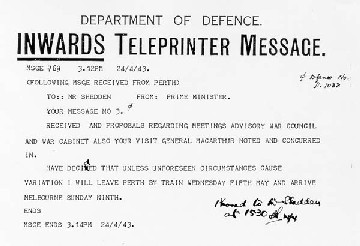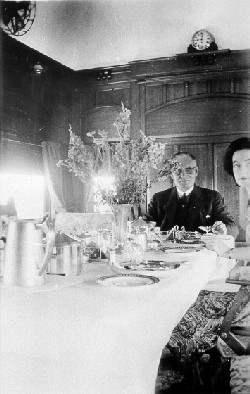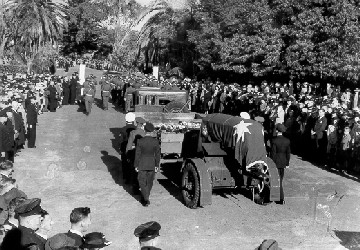
One of the tasks undertaken by the staff travelling with the Prime Minister was to collect cables at the various stopping places, decode them and type them for Curtin.
Cables, telegrams and teleprinter messages were vital means of communication for organisational as well as more serious matters in the war years. This teleprinter message from PM Curtin concerns his train journey to Melbourne for Advisory War Council and War Cabinet meetings in May 1943.
National Archives of Australia. A5954/69 1945/22
Mrs Gladys Joyce, who travelled with Curtin as his secretary on several occasions, remembers the Prime Minister saying: [11]
'That's the only time I get away from the telephone, and it's a peaceful trip for me to get over and travel by train.'
She also recalled that
John Curtin seated at the dining table in the saloon of the 'Prince of Wales' carriage.
Photograph: JCPML. Records of Gladys Joyce. John Curtin and Mary McGuire on a train, n.d. JCPML00216/2.
Find out about the Restoration of the 'Prince of Wales' carriage and view images of this Special Service Car 1 as it is today.
Others visited him as he travelled. (Dame) Rachel Cleland was travelling on the same train as Curtin when crossing the Nullarbor in October 1944. After requesting to see him, she was invited to his carriage the following day for afternoon tea and recalled: [12]
It was a fascinating few hours. I arrived at four and left at some time after six. He seemed to want to talk and discuss things but I was surprised at how free he was, especially about the row he had with Churchill re bringing our troops back to Australia. He seemed to worry about whether he had done the right thing. Naturally I assured him that the Australian public were very proud that he had stood up to Churchill, which certainly took courage.'
By this stage of the war Curtin was becoming very tired and his health was suffering. This was his last Trans Australian Railway train trip. The Hon Frank Wise, WA Government Minister, who accompanied Curtin and the WA Premier, on this trip noted that the strain of war on Curtin was becoming obvious.[13]
After his death
in July 1945, Curtin lay in state in Canberra from where his coffin was
flown to Perth on a Dakota airplane. The coffin was drawn by a gun carriage
from his Cottesloe home to Karrakatta Cemetery where a huge state funeral
was held. His final journey was complete - not by train - but he is buried
near the railway line along which he travelled so often from his Cottesloe
home.
Photograph: John Curtin Prime Ministerial Library. Records of West Australian News Ltd. Gun-carriage bearing John Curtin's coffin arrives at Karrakatta Cemetery, 1945. JCPML00347/38
Courtesy West Australian News Ltd.










